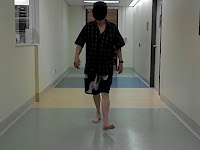Over the past few weeks heel pain has sidelined or hobbled Albert Pujol’s of the Los Angeles Angels, Mike
Napoli of the Boston Red Sox’s and Jarius Byrd of the Buffalo Bills. If you are student athlete going back to high
school or university, heel pain is something you want to avoid. Heel pain will change the way you perform
your sport.
If you are developing heel pain, you will start to notice pain
when you take your first step in the morning.
As time goes on, you will dread your first step out of bed because it is
going to be painful. With practice you will perfect a method to keep as much
weight off of your painful heel. You will
realize the pain will get a little better as the day goes on but you also know
that when you get home and sit down but have to get up again it’s going to be
painful!
One of the main reasons heel pain occurs is because the
plantar fascia pulls away from its attachment under the heel bone. This pulling away occurs with every step you
take while walking or running. The
plantar fascia has role to keep your foot stable as you lift your heel off the
ground while walking or running. The plantar fascia helps to resist your foot
from bending.
To give you an idea of what I am describing, I want you to
take your hand and place it with your palm down on top of a table. Slowly lift the palm of your hand off the
table. The more you lift your palm, the
more you will pivot on the tips of your fingers. Now bend you hand, you will feel a tightening
in the palm of your hand. You have just
stretched your palmar fascia. When you
bend your hand this is simulating what your foot is doing when you lift your
heel off the ground and the weight is on your forefoot.
When we walk or run, there is a small period
of time when all the weight of our body is only supported on one foot. During this time the heel lifts off the ground
and the foot will want to bend. If the foot is stable not much bending will
occur to stress the plantar fascia. If
your foot is unstable, the foot will bend in the middle and the plantar fascia will
try to prevent the foot from bending. This is when the damage to the plantar fascia occurs
causing heel pain.
Your foot can be unstable for a number of reasons, the most
common reason is flat feet. If your foot is unstable because you have flat feet
you may not be able to withstand the
bending forces applied to the middle of the foot especially if you play a sport
that involves running, jumping, or twisting of the foot.
Whatever sport you play make sure you have the right type of
footwear for the demands of your sport. You
may require a custom made foot orthoses to help to stabilize your foot and
prevent the bending forces on the foot. Most sports shoes will be orthotic friendly however
some sports shoes such as soccer shoes may not be orthotic friendly.
The orthotic used for
heel pain is pathology specific. It will
have wide orthotic shell to support the mid-foot joints, a deep heel cup to
stabilize the heel with and cushioning in the bottom of the heel cup.
If your heel pain has lasted for more than 2 weeks and the
intensity of the pain is getting worse you should immediately seek professional
help from a chiropodist/podiatrist or your family doctor. The longer your heel pain is left untreated,
the greater the chance it can become chronic.
The longer you have heel pain the more likely you will start to change
the way you walk or run leading other problems.
In the worst case scenario, you can develop heel pain in the other heel
because you have compensated by putting more weigh on the non-painful heel.
I routinely see patients with heel pain who have waited
longer than 4 to 6 months before they seek treatment or they have followed bad
advice. If you have chronic heel pain it
may require a longer duration of time and a more comprehensive approach to
resolve your heel pain. If your heel pain
is not chronic there is usually an easy solution for your heel pain. If you have heel pain do not let it become
chronic and get treatment at the earliest possible date.
Act quickly so you can stay in the game.




